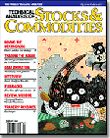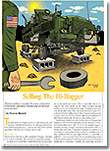Letters To The Editor
April 2009 Letters To The Editor
The editors of S&C invite readers to submit their opinions and information on subjects relating to technical analysis and this magazine. This column is our means of communication with our readers. Is there something you would like to know more (or less) about? Tell us about it. Without a source of new ideas and subjects coming from our readers, this magazine would not exist.
Address your correspondence to: Editor, Stocks & Commodities, 4757 California Ave. SW, Seattle, WA 98116-4499, or E-mail to editor@traders.com. All letters become the property of Technical Analysis, Inc. Letter-writers must include their full name and address for verification. Letters may be edited for length or clarity. The opinions expressed in this column do not necessarily represent those of the magazine. —Editor
Weinstein confusion
 Editor,
Editor,
On page 46 of the February 2009 issue of Technical Analysis of Stocks & Commodities, in the article “Weinstein’s Theory Of Relativity” by Larry Swing, Swing alludes to Stan Weinstein as the highest-percentage trader featured in Jack Schwager’s book, The Market Wizards. Is it possible that he has Stan Weinstein confused with Mark Weinstein? There’s no mention of a Stan Weinstein in Schwager’s book.
Your magazine is a must-read for all traders.
—Edward Chang
Yes, you are correct that he must have meant “Mark Weinstein.” Thank you for writing.
—Editor
Logarithmic Graphing Paper
 Editor,
Editor,
In the February 2009 issue in your Letters To S&C section, reader Allen Bains states he is looking for logarithmic paper. I wanted to let him know that logarithmic paper is provided in the classic book by Edwards and Magee, Technical Analysis Of Stock Trends.
—Jay
Thank you for providing this information.
—Editor
Automated System Testing
Editor,
I am looking for a well-tested system that can be autotraded and that makes roughly 4 to 6% a month but that doesn’t have terrible drawdowns. Do you have any ideas and have you experienced success doing this?
If I were to use several different systems, could they all be cross-collateralized at your firm?
—Sam Whittaker
You could try visiting sites such as collective2.com, Futuresexaminer.com, or FuturesTruth.com to help find trading systems that meet your criteria. Unfortunately, we do not provide system-testing results here.
—Editor
Exit Strategy
Editor,
I thoroughly enjoy and learn from all the S&C articles, including those with which I disagree, like the one that follows.
In his article “The Trading Plan” (S&C March 2009), Cory Mitchell recommends an exit strategy that limits losses to “1% of capital in use.” In his example, stock that was bought at $30 would be sold if the price dropped 1% to $29.70.
Following Mitchell’s strategy, I simulated some trades during the bear market rally on February 24. On that day, the Dow Jones Industrial Average (Djia) closed up 236. Shortly after the market opened, I bought First Solar (Fslr) at $127.84 and Goldman Sachs (GS) at $88.87. I then set a stop-loss for each at 1% below the purchased price. I held these positions for no more than five minutes when they stopped out. The same happened when I repurchased the stocks later in the day. If I had been more tolerant when I set the stop-loss, I would have held both positions and made a nice profit — that is, GS closed at $92.89 and Fslr at $137.89.
Regarding Mitchell’s strategy, if you can risk only “1% of capital in use” you should not trade this market. Rather, traders should be willing to risk a loss that is at least equivalent to the stock’s average true range. In the case of GS and Fslr, this could mean a loss of 7.5%.
—Chris Pflum
Las Vegas, NV
Any More 10-Baggers?

Editor,
I really liked Thomas Maskell’s article in the March 2009 issue of S&C (“A Collapse Or A Bubble?”), but I was disappointed to see it wasn’t about the 10-bagger strategy. Are there any plans for another article?
—Eric Johansson
It was my impression that Maskell had concluded the topic. For those who may not be familiar with the topic or the articles, the articles can be found in either Working Money or S&C:
Maskell, Thomas [2006]. “The Search For The 10-Bagger Begins,” Working-Money.com, March 23.
_____ [2006]. “The Anatomy Of The 10-Bagger,” Working-Money.com, September 5.
_____ [2007]. “Search For The 10-Bagger Fundamentals,” Working-Money.com, July 3.
_____ [2007]. “Trading The 10-Bagger,” Working-Money.com, December 4.
_____ [2008].“Speculating With The 10-Bagger,” Technical Analysis of Stocks & Commodities, Volume 26: April.
_____ [2008].“The 10-Bagger Prelaunch,” Technical Analysis of Stocks & Commodities, Volume 26: July.
_____ [2008].“Selling The 10-Bagger,” Technical Analysis of Stocks & Commodities, Volume 26: September.
_____ [2009]. “Managing Your 10-Bagger Portfolio,” Technical Analysis of Stocks & Commodities, Volume 27: January.
—Editor
Errata: February 2009 Issue
 Editor,
Editor,
I enjoyed the February 2009 issue. Your editorial was right on. The article “Support & Resistance Axioms” was very good. “How I Stopped Holding And Learned To Love The Death Cross” was also very good. But on page 20, at the bottom, in “Strategy 2,” it seems like the last statement is reversed. Shouldn’t “former” be “latter” as the death cross, and “latter” be “former” for a golden cross?
On page 52, Linda Bradford Raschke tells it like it really is. And on page 60, Candy Schaap gives us an old classic to follow the trend — trendlines are always ahead of the lagging moving averages.
On page 98, I do not understand how there can be “Optimistic Oscars.” When a trendline is broken, get out or go short.
Keep up the good work in your magazine.
—CJ Casebeer
Nampa, ID
Thank you for your comments. You are correct that “former” and “latter” were transposed.
—Editor